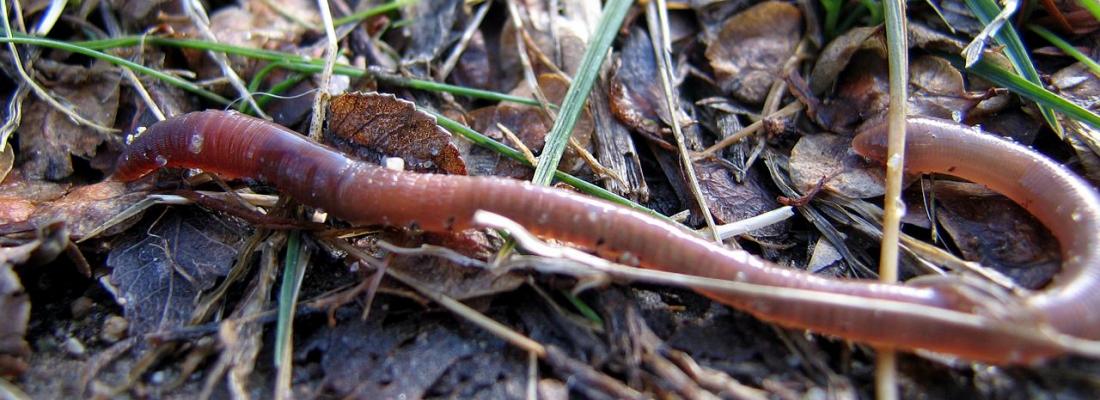Biodiversity 5 min
Earthworms: unearthing new knowledge
Soil is a wonderful place. It is home to an exceptional biodiversity in which earthworms play an important role in soil structure and function. INRAE scientists have carried out a review of their diversity and population sizes around the world, developed a revised classification, as well as a description of new species and the origin of local populations.
Published on 19 October 2020

Mixing mineral and organic matter, soil aeration, recycling of nutrients, carbon, phosphorus – via the functions they perform, earthworms are an essential element of terrestrial ecosystems. Well known to the general public, they are also a primary focus for INRAE teams, whose work in this area has produced a wealth of new knowledge.
Global diversity and distribution of earthworms
An international team of scientists including INRAE researchers analysed a large body of experimental data on earthworm communities around the world. The goal: to determine trends in the diversity, abundance and biomass of earthworms in the context of ongoing global changes.
Involving some 7,000 sites in 57 countries around the globe, the study revealed that the species are the most locally abundant in temperate regions, including Europe (150 individual worms per square meter on average), in contrast to what is observed for aboveground organisms, which show a peak in the tropics. However, diversity is greater in the tropics (60 species per site on average, compared to only about 15 in temperate regions) because the presence of species varies greatly from one place to another. Climate variables (temperature and humidity) and plant cover – not soil properties, as was previously believed – have a major influence on the abundance and diversity of earthworm communities. Over time, climate change and habitat changes could have serious consequences for earthworm communities and the functions they perform.
Towards a revised classification
In the late 1970s, a classification of French earthworms was created on the basis of their morpho-anatomy. This system quickly met with immense success, but without any formal description of how species are assigned to a given category. In order to provide a solid framework for this classification, INRAE researchers redefined these groups statistically and established that skin pigmentation, body length and skin colour were the most influential elements of this classification – in addition to 10 other morpho-anatomical features.
They propose a new classification of earthworms: below the three biggest original ecological groups at the top of the triangle – epigeic, anecics and endogeics – have been added four new categories that occupy the sides (epi-anegeic, endo-anecics, epi-endogeics) and the centre (undetermined). Only 16 species out of 125 fall entirely under a single ecological category. The others fall under one of these seven categories in varying percentages.
A real paradigm shift, these results indicate a need to assess earthworm communities no longer by assigning them to a single category, but by calculating the degree to which they belong to a given category as a percentage.
Two new earthworm species in France
Some go to the riviera islands of Hyères for the sunshine and sea. A Franco-Spanish team of researchers, in which INRAE is a stakeholder, has identified two species of earthworms which are new to science. They have been named Cataladrilus porquerollensis and Scherotheca portcrosana, based on their morphological characteristics and analyses of their genetic ties to other known species (known as a phylogeny), elements which they matched with a DNA bar code, i.e. a short and representative sequence. This discovery, which had not been made in metropolitan France for 15 years, is a sign that soil still harbours a wealth of other biodiversity.
Connected a long time ago to Corsica, Sardinia and the French mainland, these coastal islands may have served as a refuge for ancient taxonomic groups of earthworms, suggesting that the evolution of the latter is undoubtedly linked to the paleogeographic events that shook the globe at different times.
When ancient geography rhymes with the recent evolution of earthworms
These same researchers continued their work on the Iles d’Hyères. Thanks to a fundraising campaign and calibrated molecular tools that can date biological events, the team studied the origin of local populations and their genetic relationship to continental species.
These island populations have proved to be a veritable mosaic of populations:
- definitively isolated due to plate tectonics like the two newly described species not found elsewhere;
- isolated more recently during the formation of the Pyrenees (about 40 million years ago) and the Gulf of Lion and distant from the continental populations, with which they interact little;
- in interaction with their genetically similar continental counterparts, probably due to anthropogenic activities (agriculture, transport, trade) that have maintained gene flow over time.
Like Darwin's finches
The result of several mechanisms, these populations are moreover likely to modify their behaviour, similarly to Darwin's finches, linking the dynamics and functioning of populations and species – an area of research which the teams plan to explore in the near future.
This work and its results highlight the importance of better understanding soil biodiversity, and earthworms in particular, in order to meet the major health, safety and sustainability challenges facing tomorrow's soils and agriculture. They reflect the investment of INRAE teams in the field of soil biology and ecology.
Phillips HRP. et al. 2019. Global distribution of earthworm diversity. Science. 366: 480.
Marchan D. F. et al. 2020. French Mediterranean islands as a refuge of relicearthworm species: Cataladrilus porquerollensis sp. nov. and Scherotheca portcrosana sp. nov. (Crassiclitellata, Lumbricidae). European Journal of Taxonomy 701: 1.
Marchan D.F. et al. 2020. Contrasting phylogeographic patterns of earthworms (Crassiclitellata, Lumbricidae) on near-shore Mediterranean islands. European Journal of Soil Biology 101: 103242.
Bottinelli et al. 2020. An explicit definition of earthworm ecological categories – Marcel Bouché’s triangle revisited. Geoderma 372: 11436.
